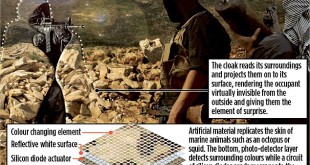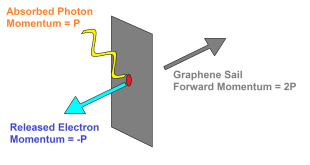Brillouin scattering is an effect caused by the χ(3) nonlinearity of a medium, specifically by that part of the nonlinearity which is related to acoustic phonons. An incident photon can be converted into a scattered photon of slightly lower energy, usually propagating in the backward direction, and a phonon.
The coupling of optical fields and acoustic waves occurs via electrostriction. The effect can occur spontaneously even at low optical powers, then reflecting the thermally generated phonon field. For higher optical powers, there can be a stimulated effect, where the optical fields substantially contribute to the phonon population.
Above a certain threshold power of a light beam in a medium, stimulated Brillouin scattering can reflect most of the power of an incident beam. This process involves a strong nonlinear optical gain for the back-reflected wave: an originally weak counterpropagating wave at the suitable optical frequency can be strongly amplified. The frequency of the reflected beam is slightly lower than that of the incident beam; the frequency difference νB corresponds to the frequency of emitted phonons.
The Brillouin gain can be used for operating a Brillouin fiber laser. Such devices are often made as fiber ring lasers. Due to low resonator loss, they can have a relatively low pump threshold and a very small linewidth.
In optical fibers, Brillouin scattering occurs essentially only in backward direction. However, rather weak forward Brillouin scattering is also possible due to effects of the acoustic waveguide.
The Brillouin frequency shift depends on the material composition and to some extent the temperature and pressure of the medium. The temperature dependence of the Brillouin shift can be used for temperature and pressure sensing in fiber-optic sensors.
Stimulated Brillouin scattering describes a way to excite coherent acoustic phonons solely by optically forces in integrated waveguides. It was shown recently that one can use these acoustic phonons to store and delay optical signals
Researchers at the University of Sydney in Australia, have figured out how to turn a light wave into a sound wave, creating an acoustic memory that they say will help data centers save energy by eliminating some electrical connections between processors. “Our vision is to replace the electronic interconnects between different processors and computing machines with photonic ‘wires,’’’ said Birgit Stiller, a postdoctoral researcher who led the project. “So light transmission will be used instead of electronic connections.”
Sound offers new directions in integrated photonics
Yale scientists have demonstrated a new method to control the behavior of light on a silicon chip — specifically, its direction — by using sound waves. This discovery appears Sept. 2018 in the journal Nature Photonics.
For decades, researchers have tried to adapt widely used optical technologies — including lasers, transmitters, and receivers — to microchip-based devices. “The field of integrated photonics offers potential breakthroughs for applications ranging from energy-efficient communications to precision sensing and quantum information,” explained Peter Rakich, an associate professor of applied physics at Yale, who led the research team. “It’s very exciting because we’re already seeing these technologies used in practical commercial systems.”
A major challenge is the lack of chip-scale technologies that can produce so-called non-reciprocal operations. These include isolators, which are “diodes” for light that permit transmission in only one direction, and circulators, which separate forward- and backward-moving light waves into separate channels. Eric Kittlaus, the study’s first author, said, “These kinds of devices are technologically important because they allow us to control and route light on a chip. For example, if we have an on-chip laser and some of its emitted light gets reflected back inside, this can severely impact the device’s performance. Using an isolator, we can make sure that light is only allowed to exit our laser.”
In most materials, light behaves the same whether it is traveling forward or backward. Existing approaches to produce commercial benchtop optical isolators typically involve synthetic garnet crystals interfaced with permanent magnets. However, when building on-chip devices, neither exotic crystals nor magnetic fields are readily available.
As a result, alternate proposals have sought to use electrical or acoustic control of chip-based optical circuits to demonstrate non-reciprocal light propagation. Thus far, these promising approaches have been hindered by problems such as excess loss of light signal or working only for light that is a single color.
By coupling light and sound on a silicon chip, Rakich’s team demonstrated that traveling ultrasound waves can produce non-reciprocal propagation for light over wavelength ranges 100 times greater than previously observed, and with practically no excess loss of the light signal. The same system has another benefit: The sound waves themselves were created using light, allowing the researchers to control the shape and direction of the ultrasound emission at will. This extra “knob” allows the same device to operate on light signals of practically any color, according to the researchers.
“Beyond the practical uses, it’s an example of very interesting and non-intuitive physics — seeing these different parts come together is very elegant,” Kittlaus said.
Nils Otterstrom, one of the paper’s co-authors said, “We’re thrilled by the scientific and technological implications of this work. Not only does this structure allow us to explore new physical phenomena, but it also represents a significant milestone towards the realization of practical chip-scale isolator and circulator technologies, one of the most significant remaining challenges facing inte
Photonic Chips Harness Sound Waves To Speed Up Local Networks
The speed of the current fibre-optic infrastructure is limited at the junctions where data jumps on or off the system. This is because increasingly complex digital signal processing and laser-based ‘local oscillator’ systems are needed to unpack the photonic, or optical, information and transfer it into the electronic information that computers can process.
The incoming photonic signal is processed in a filter on a chip made from a glass known as chalcogenide. This material has acoustic properties that allows a photonic pulse to ‘capture’ the incoming information and transport it on the chip to be processed into electronic information. “Coupling light to coherent acoustic phonons in optomechanical systems such as this one allows the velocity of an optical pulse to be slowed down, and enables a full transfer of an optical wave to an acoustic wave, which subsequently can be transferred back to the optical domain after time in storage.
The photonic-acoustic interaction harnesses what is known as stimulated Brillouin scattering, a effect used by the Sydney team to develop photonic chips for information processing. Our technique uses the interaction of photons and acoustic waves to enable an increase in signal capacity and therefore speed,” said Dr Elias Giacoumidis, joint lead author of a new study. “This allows for the successful extraction and regeneration of the signal for electronic processing at very-high speed.”
“Our demonstration device using stimulated Brillouin scattering has produced a record-breaking narrowband of about 265 megahertz bandwidth for carrier signal extraction and regeneration. This narrow bandwidth increases the overall spectral efficiency and therefore overall capacity of the system,” Dr Choudhary said.
“This will increase processing speed by microseconds, reducing latency or what is referred to as ‘lag’ in the gaming community,” said Dr Amol Choudhary from the University of Sydney Nano Institute and School of Physics. “While this doesn’t sound a lot, it will make a huge difference in high-speed services, such as the financial sector and emerging e-health applications.”
Group research leader and Director of Sydney Nano, Professor Ben Eggleton, said: “The fact that this system is lower in complexity and includes extraction speedup means it has huge potential benefit in a wide range of local and access systems such as metropolitan 5G networks, financial trading, cloud computing and the Internet-of-Things.”
University of Sydney researchers are turning optical data into readable soundwaves
Researchers at the University of Sydney have dramatically slowed digital information carried as light waves by transferring the data into sound waves in an integrated circuit, or microchip. Transferring information from the optical to acoustic domain and back again inside a chip is critical for the development of photonic integrated circuits: microchips that use light instead of electrons to manage data.
The team built a chip that consists of a spiral-shaped waveguide made from a soft glass called chalcogenide, sandwiched between two stiffer pieces of silica glass. As a light beam travels through the chip, it is met by another pulse of light that has a slightly different frequency. The difference between the frequencies of the two light beams is a “beat,” a wave with a frequency 100,000 times lower, thus turning the light wave into a sound wave. The sound wave lives for a brief time—several nanoseconds—in the spiral chalcogenide waveguide. To read it out, the device reverses the process, adding the beat frequency to a light pulse to recreate the original light wave.
Slowing down the waves provides time to synchronize different signals coming from different processors. That eliminates the need to convert the optical signal to an electronic signal. Electronics can produce excess heat and require more energy, which are important issues in the big data centers owned by Google, Amazon, or Microsoft, Stiller says.
These chips are being developed for use in telecommunications, optical fibre networks and cloud computing data centres where traditional electronic devices are susceptible to electromagnetic interference, produce too much heat or use too much energy. “The information in our chip in acoustic form travels at a velocity five orders of magnitude slower than in the optical domain,” said Dr Birgit Stiller, research fellow at the University of Sydney and supervisor of the project. “It is like the difference between thunder and lightning,” she said.
This delay allows for the data to be briefly stored and managed inside the chip for processing, retrieval and further transmission as light waves. Light is an excellent carrier of information and is useful for taking data over long distances between continents through fibre-optic cables.But this speed advantage can become a nuisance when information is being processed in computers and telecommunication systems.
To help solve these problems, lead authors Moritz Merklein and Dr Stiller, both from the ARC Centre of Excellence for Ultrahigh bandwidth Devices for Optical Systems (CUDOS) have now demonstrated a memory for digital information that coherently transfers between light and sound waves on a photonic microchip.
The chip was fabricated at the Australian National University’s Laser Physics Centre, also part of the CUDOS Centre of Excellence.
References and Resources also include:
https://www.photonics.com/Articles/Converting_Light_to_Sound_Waves_Leads_to_Hybrid/a62549
https://news.yale.edu/2018/09/17/sound-offers-new-directions-integrated-photonics
 International Defense Security & Technology Your trusted Source for News, Research and Analysis
International Defense Security & Technology Your trusted Source for News, Research and Analysis

